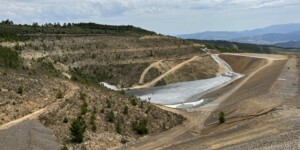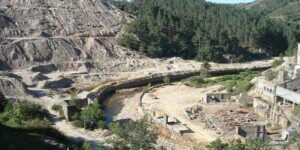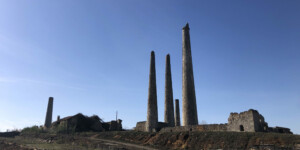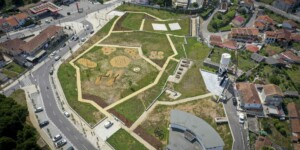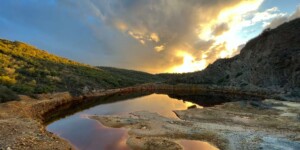The mid-conference field trips are scheduled to take place on Wednesday, during the conference. It offers attendees a welcome opportunity to take a break from the academic sessions and to witness first-hand the practical challenges and solutions in the field of Portuguese mine water management. The trips will comprise a blend of technical visits and cultural experiences, designed to provide insights into the practical challenges and solutions in the field. In addition to deepening attendees’ understanding of mine water issues, the excursion will allow them to appreciate the scenic beauty and cultural richness of northern Portugal.
The registration fee of 100 € includes excursion fees and transportation. Lunch is not included.
| Covas Mine
The Covas Mine, located in the Minho region of northwestern Portugal, has been abandoned since 1984. This former tungsten mine, set in a skarn with sulfides, still poses numerous environmental challenges. After mine closure, the waste dumps were characterized by physical instability and a lack of an adequate drainage system. The high concentration of metallic sulfides in the waste pose a substantial threat to the local water environment.
Visitors can explore the environmental remediation project, which includes: (1) reopening and redesigning perimeter clean water ditches, (2) redesigning and partially sealing waste piles in ravine areas with slopes designed for safety stabilization and reduced visual impact, (3) directing leachate water to passive treatment systems, and (4) revitalization and revegetation to promote restoration and landscape integration.
Even after passing through a passive treatment system, mine drainage retains an acidic pH and high sulfate, iron, manganese, and aluminum concentrations. As a result, streams in the mining region exhibit typical acid mine drainage characteristics. One such stream, the Ribeiro do Poço Negro, represents an extreme ecological environment that provides a unique opportunity to study the interactions between acidophilic algae and secondary minerals such as iron oxyhydroxides.
A cultural tour enriches the technical visit to the Covas Mine. Visitors will enjoy the lush Minho landscape, taste the regional pastries, and explore the historical architecture of Ponte de Lima and Vila Nova de Cerveira, two of Portugal’s oldest and most typical towns.
| São Pedro da Cova Mine
Located near Porto, the São Pedro da Cova Mine has been dealing with the issue of self-burning coal waste piles since 2005. These piles substantially impair ecosystems and human health. The discovery of coal in the late 18th century transformed São Pedro da Cova from an agrarian society to an industrial economy.
Today, the remains of the old mining complex, especially the coal processing and dispatch buildings, remain remarkable landmarks. Visitors can explore a permanent exhibition of objects and historical artifacts from the coal mining era.
The technical tour of the São Pedro da Cova Mine is complemented by a visit to the riverside towns of Porto and Gaia, where you can experience the tasting of Port Wine, renowned for its rich history and distinctive, sophisticated flavor profile, offering a unique blend of sweetness and complexity that reflects the traditional winemaking heritage of the Douro Valley.
| Pintor Mine
Canceled because of access issues to the site.
| Borralha Mining Complex
Historically, the Borralha Mining Complex comprising 52 concessions, was an important producer of wolframite with minor scheelite production (18%) until it was closed and abandoned in 1986. Mining activities included underground operations and open pit mining of vein and breccia zones, exploiting a stockwork structure.
Today, on an area of about 50 hectares, there are several waste dumps, some of them of considerable volume, old industrial facilities, including the laboratory, the two laundries, and various ruined buildings, wells and galleries. This site, located in one of the wettest regions of the Iberian Peninsula, is not only a historical mining complex. It’s also an important environmental site, drained by numerous watercourses that receive water affected by mining, making it an interesting case study in environmental protection.
The technical visit to the Borralha Mining Complex will be a truly enriching experience. Participants will not only explore the industrial history of the complex, but also immerse themselves in the natural wonders of the Barroso region and the nearby Gerês National Park. They will be able to observe the region’s stunning landscapes, endemic flora and fauna, and interesting geological features that contribute to its designation as a UNESCO Global Geopark. This complementary experience will provide a holistic understanding of the area’s natural and geological heritage, enhancing the appreciation of its industrial history and environmental relevance.

